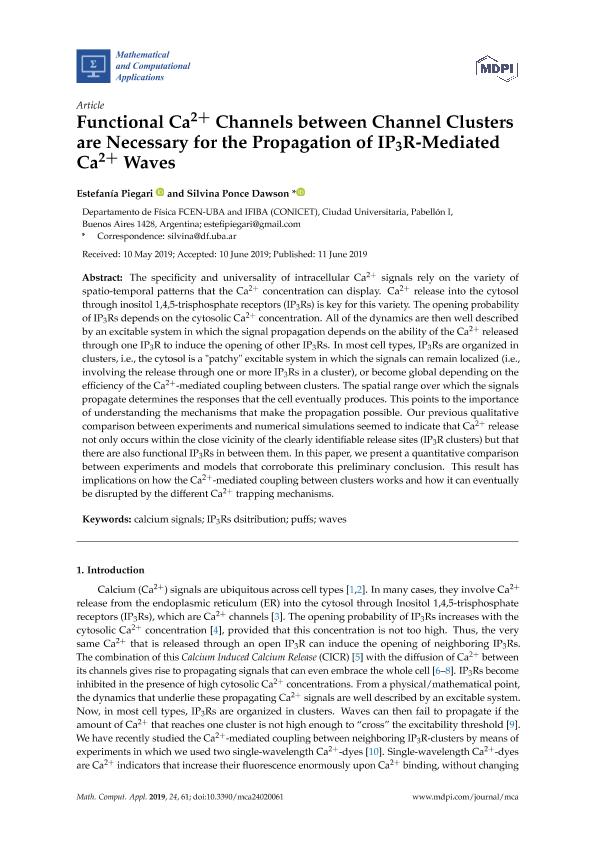Mostrar el registro sencillo del ítem
dc.contributor.author
Piegari, Estefanía

dc.contributor.author
Ponce Dawson, Silvina Martha

dc.date.available
2020-12-22T20:22:30Z
dc.date.issued
2019-06-11
dc.identifier.citation
Piegari, Estefanía; Ponce Dawson, Silvina Martha; Functional Ca2+ Channels between Channel Clusters are Necessary for the Propagation of IP3R-Mediated Ca2+ Waves; Multidisciplinary Digital Publishing Institute; Mathematical and Computational Applications; 24; 2; 11-6-2019; 1-14
dc.identifier.uri
http://hdl.handle.net/11336/121079
dc.description.abstract
The specificity and universality of intracellular Ca2+ signals rely on the variety of spatio-temporal patterns that the Ca2+ concentration can display. Ca2+ release into the cytosol through inositol 1,4,5-trisphosphate receptors (IP 3 Rs) is key for this variety. The opening probability of IP3Rs depends on the cytosolic Ca2+ concentration. All of the dynamics are then well described by an excitable system in which the signal propagation depends on the ability of the Ca2+ released through one IP3R to induce the opening of other IP3Rs. In most cell types, IP3Rs are organized in clusters, i.e., the cytosol is a "patchy" excitable system in which the signals can remain localized (i.e., involving the release through one or more IP3Rs in a cluster), or become global depending on the efficiency of the Ca2+ -mediated coupling between clusters. The spatial range over which the signals propagate determines the responses that the cell eventually produces. This points to the importance of understanding the mechanisms that make the propagation possible. Our previous qualitative comparison between experiments and numerical simulations seemed to indicate that Ca2+ release not only occurs within the close vicinity of the clearly identifiable release sites (IP3R clusters) but that there are also functional IP3Rs in between them. In this paper, we present a quantitative comparison between experiments and models that corroborate this preliminary conclusion. This result has implications on how the Ca2+-mediated coupling between clusters works and how it can eventually be disrupted by the different Ca2+ trapping mechanisms.
dc.format
application/pdf
dc.language.iso
eng
dc.publisher
Multidisciplinary Digital Publishing Institute
dc.rights
info:eu-repo/semantics/openAccess
dc.rights.uri
https://creativecommons.org/licenses/by-nc-sa/2.5/ar/
dc.subject
CALCIUM
dc.subject
IP3R
dc.subject
CALCIUM-INDUCED-CALCIUM-RELEASE
dc.subject
WAVES
dc.subject.classification
Otras Ciencias Físicas

dc.subject.classification
Ciencias Físicas

dc.subject.classification
CIENCIAS NATURALES Y EXACTAS

dc.title
Functional Ca2+ Channels between Channel Clusters are Necessary for the Propagation of IP3R-Mediated Ca2+ Waves
dc.type
info:eu-repo/semantics/article
dc.type
info:ar-repo/semantics/artículo
dc.type
info:eu-repo/semantics/publishedVersion
dc.date.updated
2020-11-20T15:54:41Z
dc.identifier.eissn
2297-8747
dc.journal.volume
24
dc.journal.number
2
dc.journal.pagination
1-14
dc.journal.pais
Suiza

dc.description.fil
Fil: Piegari, Estefanía. Universidad de Buenos Aires. Facultad de Ciencias Exactas y Naturales. Departamento de Física; Argentina. Consejo Nacional de Investigaciones Científicas y Técnicas. Oficina de Coordinación Administrativa Ciudad Universitaria. Instituto de Física de Buenos Aires. Universidad de Buenos Aires. Facultad de Ciencias Exactas y Naturales. Instituto de Física de Buenos Aires; Argentina
dc.description.fil
Fil: Ponce Dawson, Silvina Martha. Universidad de Buenos Aires. Facultad de Ciencias Exactas y Naturales. Departamento de Física; Argentina. Consejo Nacional de Investigaciones Científicas y Técnicas. Oficina de Coordinación Administrativa Ciudad Universitaria. Instituto de Física de Buenos Aires. Universidad de Buenos Aires. Facultad de Ciencias Exactas y Naturales. Instituto de Física de Buenos Aires; Argentina
dc.journal.title
Mathematical and Computational Applications
dc.relation.alternativeid
info:eu-repo/semantics/altIdentifier/url/https://www.mdpi.com/2297-8747/24/2/61
dc.relation.alternativeid
info:eu-repo/semantics/altIdentifier/doi/http://dx.doi.org/ 10.3390/mca24020061
Archivos asociados
